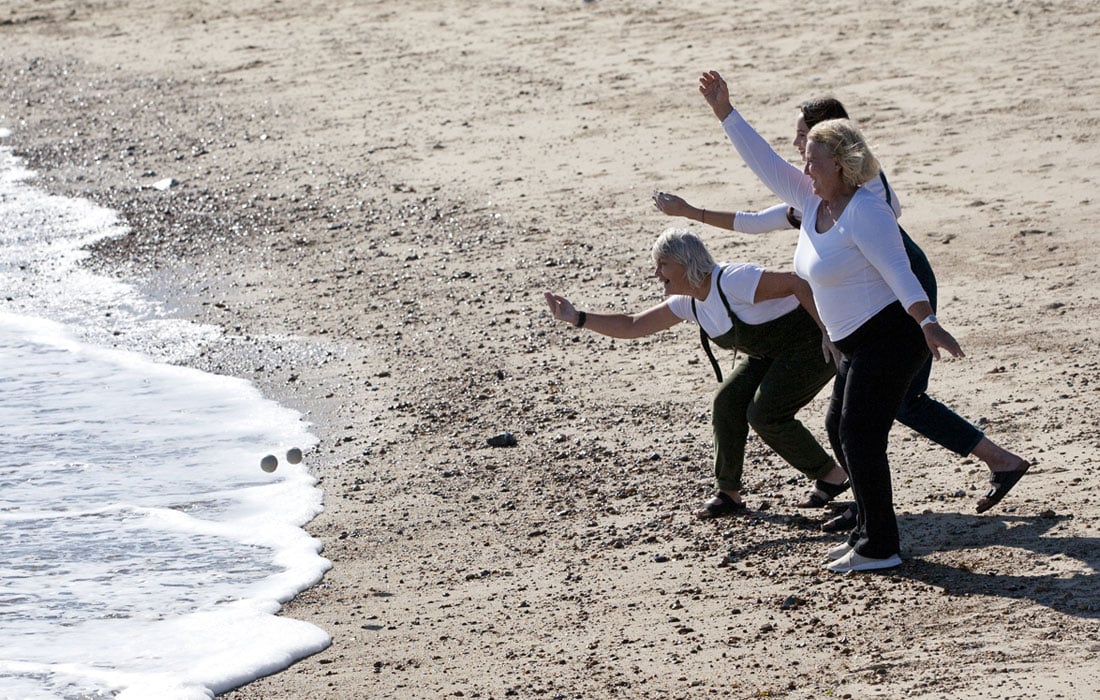
Caroline Wright’s project ‘Breath control’
Photo: © Tony Millings
A breath of fresh air
The port town of Felixstowe proved an ideal setting for exploring less cerebral ways of engaging with contemporary art, writes Natalie Pace.
Pier Projects was formed by myself and art educator Louise Stratford following conversations we had in a gym – an unconventional location, granted, but one that directly speaks the idea that grounds our work: a holistic understanding of mind and body. These conversations fed our thinking about why we felt that intellectual responses to contemporary art were often emphasised over affective or physical ones. We wanted to address this perceived imbalance and support artist-led activity that probed the gamut of human experience.
The impact of the performances on the participants and their emotional responses were quite unexpected
When thinking about context, the historic role of British coastal towns as places for contemplation and relaxation resonated with our enquiry and felt like a natural home. We wanted to work in a location we had a particular affinity with, and the port town of Felixstowe in Suffolk, where Louise is both a beach-hut owner and part of the open water swimming community, seemed like the natural choice. A period of research and consultation enhanced our local knowledge and shaped our view that there was space for a new art programme.
Our interests, instinct and research all pointed to curating in the public realm through a residency model, to embed artists in the locality. And to engage new, non-traditional art audiences, it seemed logical to program across the summer, when Felixstowe was busier and outdoor activity more prolific.
These formative ideas were put into practice through Thrive | Revive, funded by Arts Council England and Suffolk Coastal District Council. It comprised public art interventions and performances alongside an engagement programme for young people, thanks to a partnership with local charity Level Two. We worked with two artists, Caroline Wright and Adam Bridgland, who had extensive experience of working beyond gallery walls.
Performances in a beach hut
Caroline's project 'Breath Control' was presented it in an intimate way through a temporary residency in a beach hut, called 'Breathing Hut'. She worked collaboratively with soprano Laura Wright and the local community to investigate perceptions of air quality by the sea. Inspired by conversations and shared experiences, the artists worked towards short performances for small audiences.
It operated on multiple registers and levels of participation, and those who took part included both an art audience who had travelled specially to be involved, and passers-by who were encouraged to join in. Participation required a leap of faith and a brave spirit. Taking place in a beach hut that provided no prior information about what would take place inside, other than the sound of voices in song it emitted, the project was unnerving to some.
The impact of the performances on the participants and their emotional responses were quite unexpected. One participant wrote in a letter how he had never "foreseen the surreal effect [of the work]. I honestly thought taking part would, in some small way, help you… but, since Saturday, we feel like we have been living in a dream”.
Public art
Adam’s residency expanded his screen print 'Upon Every Wave' and developed into two pieces of public art. The first, 'Out to Sea', a vinyl image with text, was located in a shop window – this element of the project was not part of our initial plans, but emerged as we explored different options for locating Adam's work. We were pleased to find a landlord who was open to working with us, and the image raised important questions about notions of private and public space and demonstrated an understanding that artists were important within regeneration.
Adam’s second work was presented as a wooden sign-like structure in which the words 'Upon Every Wave Our Wellbeing Rides' were cut out to reveal the horizon and seascape. Situated in front of Old Felixstowe’s Martello Tower with the North Sea as a backdrop, it seemed to grow out of the landscape.
The coastal context
Caroline and Adam may have differed in their varied approaches to working in the public realm – the degree to which they required direct engagement and participation between artist and viewer – but both imbued a slowness and intimacy that reflected the coastal context.
Our reflection took place against the backdrop of ongoing Brexit discussions, and the associated confusion and uncertainty about how we define our nation and our communities. There is perhaps no more significant moment in recent history than this to open up conversations about place, participation and publics. The role of artists – so thoughtfully articulated in the letter written to Caroline Wright – is central to this process.
Natalie Pace is a curator and writer.
www.nataliepace.co.uk
Tw @natalie_pace_
Join the Discussion
You must be logged in to post a comment.